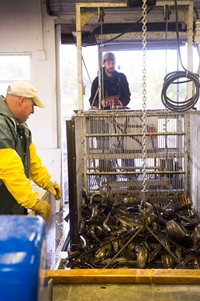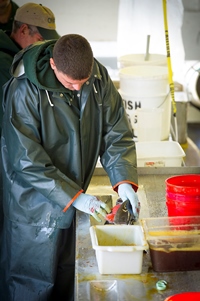Platte River State Fish Hatchery a big part of state's success with coho salmon
 Some years back, when Michigan’s Chinook salmon program was in its greatest glory, some anglers suggested the Department of Natural Resources abandon raising the smaller, less spectacular coho salmon and put more emphasis on the kings. The DNR demurred, preferring a multispecies approach. Some years back, when Michigan’s Chinook salmon program was in its greatest glory, some anglers suggested the Department of Natural Resources abandon raising the smaller, less spectacular coho salmon and put more emphasis on the kings. The DNR demurred, preferring a multispecies approach.
It appears to have been a wise strategy; Chinook salmon populations are down significantly, largely because of stocking cuts necessitated by a diminishing alewife population in Lake Michigan.
Chinooks depend almost entirely on alewives for their diet. Cohos are more adaptable. As a result, the coho population remains strong. It helped fill out the catch this past summer, as there were fewer Chinooks available to anglers.
Now, the DNR stocks nearly as many coho salmon as Chinooks. A decade ago, it was a quarter as many.
None of this was lost with the DNR crew this fall as they took coho eggs at Platte River State Fish Hatchery near Honor.
“This is the birthplace of Michigan salmon, the only coho salmon facility we have,” said Aaron Switzer, the supervisor for all three of the northern Lower Peninsula’s fish hatcheries. “This is where we put them when they first came here, this is where we get the best returns, and this is the best place for a rearing facility.
 “The Platte River hatchery is perfect for salmon rearing,” Switzer said. “The water doesn’t get too warm. It does get cold in the winter – we’ve got to heat the water in winter – but we get good growth and we can predict when a lot of the intensive fish-culture work will take place.” “The Platte River hatchery is perfect for salmon rearing,” Switzer said. “The water doesn’t get too warm. It does get cold in the winter – we’ve got to heat the water in winter – but we get good growth and we can predict when a lot of the intensive fish-culture work will take place.”
There are two weirs on the Platte River – the lower weir controls how many fish are allowed upstream to the upper weir, located at the hatchery. The hatchery operates under an unusual set of circumstances; the number of fish allowed to make their way up to the hatchery is controlled by a consent judgement between the DNR and the Platte Lake Improvement Association, which is downstream from the hatchery.
When the fish hit the upper weir, they slide off to the side into a holding area where they’ll stay until egg take begins. The fish from the holding area are herded into an area immediately below the hatchery entrance, where they’re collected in a cage, sedated with carbon dioxide to facilitate handling, and raised to a table. They’re dispatched with pneumatic devices and bathed in an iodine solution to kill any external bacteria.
The females are opened up and the eggs are placed in a container. The carcass is inspected for anything unusual, such as water in the body cavity or nodules or discoloration of internal organs, and eggs are discarded if the workers detect any problems with the fish.
Meanwhile, males are stripped of their milt into cups, and their carcasses are inspected. Again, if anything appears amiss, the milt is discarded.
When the milt is added to the eggs – milt from one male is mixed with eggs from one female – fertilization is almost instantaneous.
 “We only leave them like that for about 60 seconds,” said Switzer. “We dump that water off, and add a solution of Erythromycin (an antibiotic) and thiamine (vitamin B1). The vitamin B1 prevents early mortality syndrome.” “We only leave them like that for about 60 seconds,” said Switzer. “We dump that water off, and add a solution of Erythromycin (an antibiotic) and thiamine (vitamin B1). The vitamin B1 prevents early mortality syndrome.”
The eggs are water-hardened in 5-gallon buckets for an hour, and then moved indoors where they’re placed in incubator trays.
Eggs will “eye-up” – when the eyes of a developing fish are visible – in about 30 days. The eggs are shocked; they’re dumped at some height from the trays through a funnel into 5-gallon buckets. Any dead or nonviable eggs will crack. The next day, they’re put in a salt solution. Dead eggs float.
“We can scoop them out and discard them,” Switzer said. “It’s really a slick process for getting through millions of eggs in a couple of days.”
The viable eggs, which have been returned to trays, will hatch in 30 days. The hatchlings will absorb their egg sacs and learn to swim over the next 30 days, when they’re transferred into indoor tanks. They remain in the tanks until summer, when they’re moved to outdoor raceways where they’ll remain until the following spring.
“All they do is grow out there,” Switzer said. “The fish we spawn in the fall of 2015 will not be planted until April of 2017.”
 The DNR took approximately 2.8 million coho eggs to produce the 1.45 million fish for stocking. It wasn’t without its challenges this year; egg-take didn’t begin until later than usual this fall because the females weren’t ripe on schedule. The DNR took approximately 2.8 million coho eggs to produce the 1.45 million fish for stocking. It wasn’t without its challenges this year; egg-take didn’t begin until later than usual this fall because the females weren’t ripe on schedule.
“Coho were late this year and we’re not sure why,” said Paul Stowe, the hatchery manager. “I don’t know if it’s a function of water temperature, either in Lake Michigan or the Platter River. It seems strange; a lot of what controls the spawning timing is photo period and that didn’t change. But there are secondary factors that dictate when these fish are actually ready.”
Apparently those secondary factors are in place elsewhere, as Michigan isn’t the only Great Lakes state behind on coho egg-take this year.
“We got a request from Wisconsin for eggs earlier this fall because they said they weren’t seeing any fish at their egg-take site,” Stowe said. “But then I got a note just the other day saying that that water flow in the stream at one of their egg-take weirs had increased and they were starting to see some more fish, and they thought they may be okay.”
The hatchery’s first stab at egg-take, in mid-October, was slowed by mechanical difficulties and too many not-yet-mature fish. By the end of the month, however, the problems were ironed out and egg-take went swimmingly. Once Michigan’s quota was met, the crew at Platte River collected additional eggs for the Indiana and Illinois departments of natural resources – which depend on eggs from Michigan coho for their hatchery programs – and the Wisconsin DNR, if they are needed. The Platte River hatchery crew will keep the eggs until eye-up, and then distribute them evenly if it can meet the full requests of the various states.
“Their programs are important to the Lake Michigan fishery,” Switzer said.
For more information on Michigan fish hatcheries, visit www.michigan.gov/hatcheries.
/Note to editors: Photos to accompany this story are available for download at www.michigandnr.com/ftp/outreach in the folder marked “Platte Hatchery Egg Take” (Michigan DNR photos)
Captions:
DSK 530 102: Platte River State Fish Hatchery manager Paul Stowe uses a crowder to herd salmon into an area to be pushed into the hatchery building.
DSK 530 133: A cage full of coho salmon is lifted onto a table for egg-take at the Platte River State Fish Hatchery.
DSK 530 163: A fisheries worker removes eggs from a coho salmon to be used at the Platte River State Fish Hatchery.
DSK 530 176: Fertilized coho eggs await transfer to the Platte River State Fish Hatchery’s incubation room.
DSK 530 95: Fisheries worker Bob Eggleston transfers fertilized eggs to a tray in the incubator room at Platte River State Fish Hatchery./
The Michigan Department of Natural Resources is committed to the conservation, protection, management, use and enjoyment of the state’s natural and cultural resources for current and future generations. For more information, go to www.michigan.gov/dnr.
|

 Some years back, when Michigan’s Chinook salmon program was in its greatest glory, some anglers suggested the Department of Natural Resources abandon raising the smaller, less spectacular coho salmon and put more emphasis on the kings. The DNR demurred, preferring a multispecies approach.
Some years back, when Michigan’s Chinook salmon program was in its greatest glory, some anglers suggested the Department of Natural Resources abandon raising the smaller, less spectacular coho salmon and put more emphasis on the kings. The DNR demurred, preferring a multispecies approach. “The Platte River hatchery is perfect for salmon rearing,” Switzer said. “The water doesn’t get too warm. It does get cold in the winter – we’ve got to heat the water in winter – but we get good growth and we can predict when a lot of the intensive fish-culture work will take place.”
“The Platte River hatchery is perfect for salmon rearing,” Switzer said. “The water doesn’t get too warm. It does get cold in the winter – we’ve got to heat the water in winter – but we get good growth and we can predict when a lot of the intensive fish-culture work will take place.” “We only leave them like that for about 60 seconds,” said Switzer. “We dump that water off, and add a solution of Erythromycin (an antibiotic) and thiamine (vitamin B1). The vitamin B1 prevents early mortality syndrome.”
“We only leave them like that for about 60 seconds,” said Switzer. “We dump that water off, and add a solution of Erythromycin (an antibiotic) and thiamine (vitamin B1). The vitamin B1 prevents early mortality syndrome.” The DNR took approximately 2.8 million coho eggs to produce the 1.45 million fish for stocking. It wasn’t without its challenges this year; egg-take didn’t begin until later than usual this fall because the females weren’t ripe on schedule.
The DNR took approximately 2.8 million coho eggs to produce the 1.45 million fish for stocking. It wasn’t without its challenges this year; egg-take didn’t begin until later than usual this fall because the females weren’t ripe on schedule.




